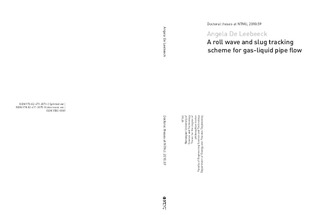| dc.contributor.author | De Leebeeck, Angela | nb_NO |
| dc.date.accessioned | 2014-12-19T11:45:58Z | |
| dc.date.available | 2014-12-19T11:45:58Z | |
| dc.date.created | 2010-11-04 | nb_NO |
| dc.date.issued | 2010 | nb_NO |
| dc.identifier | 360765 | nb_NO |
| dc.identifier.isbn | 978-82-471-2075-0 (electronic ver.) | nb_NO |
| dc.identifier.isbn | 978-82-471-2074-3 (printed ver.) | nb_NO |
| dc.identifier.uri | http://hdl.handle.net/11250/234136 | |
| dc.description.abstract | The main objective of this work is to explore ways of introducing large roll waves as computational objects into a one-dimensional slug tracking scheme for gas-liquid pipe flow. The tracking scheme uses a moving and adaptive grid, as opposed to capturing schemes which require a fine grid to resolve sharp fronts. Experiments on the dynamic behavior of individual waves were made and following that, an integral wave model that is simple, dynamic and allows continuous transition to slug flow and stratified flow was developed.
In the first part of this work, an existing steady state roll wave model and a commercial multiphase flow simulator were compared to existing experimental data on a gascondensate system so that current methods of modelling large amplitude waves could be investigated. This comparison resulted in similarly accurate predictions from both simulation methods.
Secondly, due to similarities between large waves and slugs, and a lack of pressure data on waves in the literature, the pressure change across roll wave fronts in air-water pipe flow at atmospheric pressure was measured experimentally. Holdup and pressure time traces along with synchronized video recordings showed that large roll waves were associated with a pressure jump.
These pressure measurements and other similarities between roll waves and slugs formed a basis for modelling wave fronts as moving objects with a pressure variation across them in a tracking scheme. A model is proposed where the pressure variation corresponding to liquid acceleration at the wave front is equal to an orifice type loss in the gas phase. The wave model also includes a simplified relationship for wave speed, allowing for smooth transition to slug flow. The large roll wave model was implemented and tested in the slug tracking scheme and model dynamics such as a waves growing to slugs and slugs decaying to waves were also demonstrated.
The roll wave model and its incorporation in the tracking scheme as well as its demonstration in comparison to data made up the third and fourth parts of this work. In the third part, simulations gave a reasonable approximation of wave speeds and pressure drops from the experiments at atmospheric pressure. The simulations also compared well to other experiments on roll waves at high gas densities when waves were initiated at the experimental frequency.
In the final part of this work, simulations with the tracking scheme were compared to experiments where a water front enters an initially empty undulating pipeline. The pipeline was either flushed with water or the flow would stop if there was insufficient inlet pressure. The end states of the simulation compared favorably with experiments but differed in the time to reach the final state. Slug formation, decay, and bubble turning were also observed in the simulations as in the experiments. | nb_NO |
| dc.language | eng | nb_NO |
| dc.publisher | NTNU | nb_NO |
| dc.relation.ispartofseries | Doktoravhandlinger ved NTNU, 1503-8181; 2010:59 | nb_NO |
| dc.relation.haspart | De Leebeeck, A.; Nydal, O. J.; Johnson, G. W.; Monsen, J. I.; Goldszal, A.. Comparison of two phase pipe flow experiments with a roll wave model and a commercial simulator. , 2008. | nb_NO |
| dc.relation.haspart | De Leebeeck, A.; Nydal, O. J.. Large amplitude waves in a slug tracking scheme. <em><em>Computational Methods in Multiphase Flow V</em></em>: 99-109, 2009. | nb_NO |
| dc.relation.haspart | De Leebeeck, A.; Nydal, O. J.. Experiments on large roll waves in air-water pipe flow at atmospheric pressure. . | nb_NO |
| dc.relation.haspart | De Leebeeck, A.; Nydal, O. J.. Simulation of large amplitude waves in a slug tracking scheme compared to roll wave experiments at high pressure. International Journal of Multiphase Flow. (ISSN 0301-9322). 36(1): 40-50, 2010. <a href='http://dx.doi.org/10.1016/j.ijmultiphaseflow.2009.09.002'>10.1016/j.ijmultiphaseflow.2009.09.002</a>. | nb_NO |
| dc.relation.haspart | De Leebeeck, A.; Winnem, A. N.; Nydal, O. J.. Liquid flushing of an undulating pipeline. . | nb_NO |
| dc.relation.haspart | De Leebeeck, Angela; Gaarder, Andreas Hoel; Nydal, Ole Jørgen. Experiments on Roll Waves in Air-Water Pipe Flow. , 2007. | nb_NO |
| dc.title | A roll wave and slug tracking scheme for gas-liquid pipe flow | nb_NO |
| dc.type | Doctoral thesis | nb_NO |
| dc.contributor.department | Norges teknisk-naturvitenskapelige universitet, Fakultet for ingeniørvitenskap og teknologi, Institutt for energi- og prosessteknikk | nb_NO |
| dc.description.degree | PhD i energi- og prosessteknikk | nb_NO |
| dc.description.degree | PhD in Energy and Process Engineering | en_GB |
